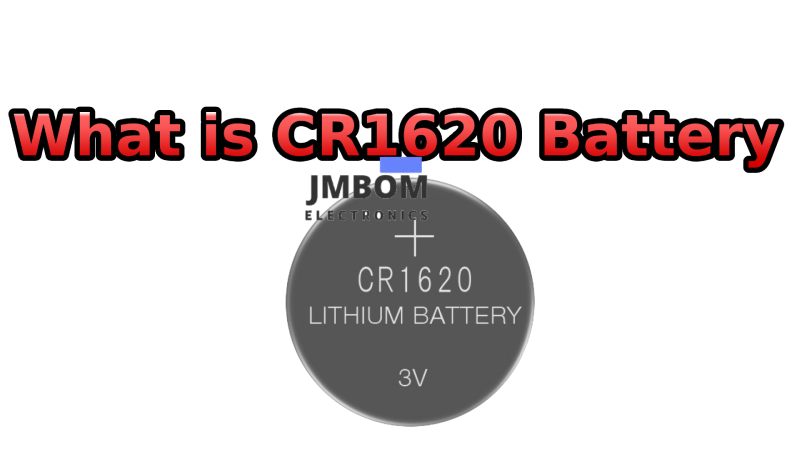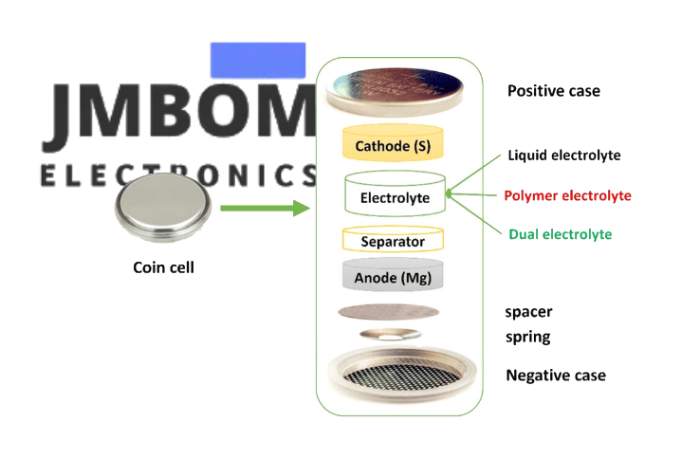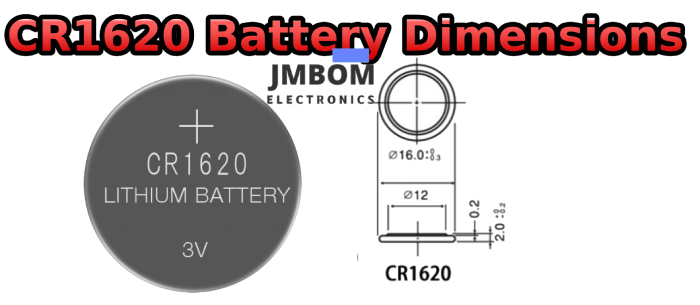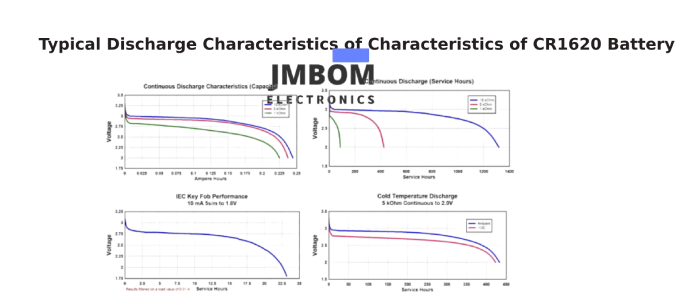

What is CR1620 Battery
Catalog
What is the CR1620 Battery?Chemical Composition of CR1620 BatteryCR1620 Battery FeaturesCR1620 Battery DimensionsCR1620 Battery DetailsCR1620 Battery UsesCR1620 Battery EquivalentWhy Choose the CR1620 Battery?Discharge Characteristics of CR1620 BatteryHow Long Does a CR1620 Battery Last? Is a CR1616 Battery the Same as a CR1620?Frequently Ask QuestionsRelated ArticlesDescription of CR1620 Battery
The CR1620 is a non-rechargeable lithium button/coin cell battery widely used in numerous electronic devices. It has a diameter of 16.0 mm and a height of 2.0 mm, providing a nominal voltage of 3.0 volts and a capacity ranging from 65 to 80 mAh, which can vary based on factors such as age and discharge rate. Premium models boast even lower self-discharge rates, typically between 1-2% per year.
What is the CR1620 Battery?
The CR1620 is a non-rechargeable lithium button/coin cell battery that is commonly used in a variety of electronic devices. It measures 16.0 mm in diameter and 2.0 mm in height, offers a nominal voltage of 3.0 volts, and has a capacity between 65 and 80 mAh. This capacity can fluctuate depending on factors like age and discharge rate. Premium versions of the CR1620 are known for their exceptionally low self-discharge rates, which can be as low as 1-2% per year.
The CR1620 is often used in applications such as car keys, digital watches, remote controls, CMOS/motherboard batteries, and medical devices like glucometers. It is frequently compared to similar batteries, including the CR1616 (which has a smaller capacity), the BR1620 (which has lower capacity and drain current), the LiR1620 (which is rechargeable and has a higher voltage but lower capacity), and the ML1620 (which is rechargeable but less commonly used). The CR1620's advantages include its high energy density, stable voltage over time, and excellent resistance to leakage, making it a reliable choice for long-term use in various devices.

CR1620 Battery
Chemical Composition of CR1620 Battery

Cathode (Positive Electrode)
- Material: Manganese dioxide (MnO₂)
- Function: During discharge, it accepts electrons, serving as the oxidizing agent.
- Characteristics: It ensures a stable voltage and high energy density.
Anode (Negative Electrode)
- Material: Lithium metal (Li)
- Function: During discharge, it donates electrons, acting as the reducing agent.
- Characteristics: It is lightweight, has a high electrochemical potential, and contributes to the battery's high energy density.
Electrolyte
- Material: An organic solvent with dissolved lithium salt, such as lithium perchlorate (LiClO₄) in propylene carbonate (PC) and 1,2-dimethoxyethane (DME).
- Function: It enables the movement of lithium ions between the cathode and anode during charging and discharging.
- Characteristics: It maintains ionic conductivity and stability across a wide temperature range.
Separator
- Material: Microporous polyethylene or polypropylene film.
- Function: It prevents direct contact between the anode and cathode to avoid short circuits, while allowing ion flow.
- Characteristics: It is chemically inert and strong enough to handle internal pressures.
Housing
- Material: Stainless steel.
- Function: It houses the internal components, providing structural support and external protection.
- Characteristics: It is corrosion-resistant and durable.
CR1620 Battery Features
The CR1620 battery is a well-known lithium coin cell appreciated for its small size and dependable performance. Here are the key features of the CR1620 battery:
Voltage: The CR1620 operates at a nominal voltage of 3.0 volts, making it suitable for a wide range of electronic devices that require a stable power source.
Capacity: It typically has a capacity between 65 mAh and 81 mAh, depending on the manufacturer and specific model. This capacity allows for extended use in devices.
Dimensions: The battery measures 16 mm in diameter and 2 mm in height, which is standard for this type of coin cell battery.
Weight: It weighs approximately 1.3 grams, making it lightweight and easy to handle.
Operating Temperature: The CR1620 can function effectively in a wide temperature range, typically from -30°C to 60°C, enhancing its versatility in various environments.
Self-discharge Rate: It has a low self-discharge rate of about 1% per year, allowing for a long shelf life—up to 10 years when stored properly.
Leakage Resistance: The CR1620 features excellent leakage resistance due to advanced construction and electrolyte technology, ensuring reliability over time.
Applications: Commonly used in devices such as watches, calculators, remote controls, key fobs, and medical devices, the CR1620 is favored for its high energy density and stable voltage characteristics.
Safety Standards: The CR1620 battery complies with safety regulations, including UL approval and RoHS directives, ensuring it is free from hazardous materials like mercury and cadmium.
CR1620 Battery Dimensions

CR1620 Battery Details
The CR1620 battery is a popular lithium coin cell battery, appreciated for its small size and dependable performance. Here are the detailed specifications:
| Feature | Specification |
| Type | Lithium Manganese Dioxide (Li/MnO2) |
| Nominal Voltage | 3.0 Volts |
| Nominal Capacity | 70-81 mAh (varies by manufacturer) |
| Dimensions | 16 mm diameter x 2 mm height |
| Weight | Approximately 1.3 grams |
| Operating Temperature | -30°C to 60°C |
| Self-Discharge Rate | ~1% per year |
| Shelf Life | Up to 10 years |
| Max Continuous Load | Typically around 30 kΩ |
| Instant Short-Circuit Current | Up to 200 mA |
| Energy Density | Approximately 164 mWh/g |
CR1620 Battery Uses
Main Applications of Pkcell CR1620
- Watches
- Car Remote Keys
- Computer CMOS
- Medical Devices
- Memory Backup
- Wireless Sensors
- Electronic Toys
The CR1620 battery is a highly versatile lithium coin cell that is widely used in many electronic devices because of its small size and reliable performance. Here are some of the main uses for the CR1620 battery:
- Watches: It is commonly used in digital watches and other timekeeping devices to provide long-lasting power.
- Remote Controls: It powers remote controls for televisions, garage doors, and other electronic devices.
- Key Fobs: It is used in car keyless entry systems and remote key fobs for added convenience and security.
- Calculators: It ensures consistent operation of handheld calculators over time.
- Toys: It is used in various electronic toys and games that require small batteries.
- Medical Devices: It is found in medical equipment such as glucometers, heart rate monitors, and other portable health devices.
- Cameras: It is used in some digital cameras and photographic equipment for memory backup and clock functions.
- Fitness Trackers: It powers fitness devices and smartwatches, providing energy-efficient performance.
- Home Security Systems: It is used in alarm systems and motion detectors for reliable operation.
- LED Flashlights: It is used in compact LED flashlights to provide portable lighting solutions.
CR1620 Battery Equivalent
| Battery Model | Type | Voltage (Nominal) | Capacity | Applications |
| CR1620 | Non-rechargeable Lithium Coin | 3.0V | 65-80 mAh | Watches, key fobs, medical devices, small electronics |
| DL1620 | Duracell Lithium Coin Battery | 3.0V | 70 mAh | Watches, key fobs, medical devices |
| ECR1620 | Energizer Lithium Coin Battery | 3.0V | 70 mAh | Calculators, small electronics, security devices |
| BR1620 | Panasonic Lithium Coin (Poly-carbon monofluoride) | 3.0V | 55 mAh | Industrial applications, high-temperature environments |
| 5009LC | General Lithium Coin Equivalent | 3.0V | Similar to CR1620 | Small Electronics |
| L08 | Common Lithium Coin Equivalent | 3.0V | Similar to CR1620 | Remote controls, medical devices |
| KCR1620 | Kodak Lithium Coin Battery | 3.0V | 70 mAh | Cameras, key fobs |
| ML1620 | Rechargeable Lithium Manganese Dioxide | 3.0V | Lower than CR1620 | Can replace CR1620, but has a higher self-discharge rate |
| LiR1620 | Rechargeable Lithium Battery | 3.6-3.7V | Lower than CR1620 | Rarely used in devices designed for CR1620 due to different voltage |
The CR1620 battery has several interchangeable models that can be used as substitutes, with most alternatives providing a similar nominal voltage (3.0V) and comparable capacities (around 70 mAh). Some of the most well-known equivalents include the DL1620, ECR1620, and KCR1620, which are suitable for applications such as watches, key fobs, and medical devices. For industrial uses or high-temperature environments, the BR1620 is an ideal choice due to its unique composition. Rechargeable alternatives, like the ML1620 and LiR1620, offer different voltage characteristics and capacities. While they can replace the CR1620 in certain scenarios, they are not as commonly used due to these differences. It's important to verify the compatibility of the equivalent battery based on voltage, dimensions, and capacity to ensure the proper functioning of the device.
Why Choose the CR1620 Battery?
The CR1620 battery offers several advantages that make it a preferred choice for powering various electronic devices. Here are the key benefits:
High Voltage and Energy Density: The CR1620 operates at 3.0 volts, delivering nearly double the voltage of standard alkaline batteries. This allows devices to run more efficiently, often requiring fewer batteries. As a result, it saves space and reduces overall weight.
Stable Discharge Characteristics: Throughout its discharge cycle, the CR1620 maintains a stable voltage. This consistency significantly enhances device reliability, reducing the need for maintenance and minimizing the frequency of battery replacements.
Low Self-Discharge Rate: The CR1620 has an annual self-discharge rate of less than 1%. When stored properly, it can retain its charge for up to 10 years. This long shelf life is especially advantageous for devices that are used infrequently.
Superior Leakage Resistance: Thanks to its advanced construction and electrolyte formulation, the CR1620 offers excellent resistance to leakage. This ensures the battery remains safe and effective over time.
Wide Operating Temperature Range: The CR1620 can function effectively in temperatures ranging from -30°C to 60°C. This makes it suitable for a variety of environments, including extreme conditions.
Lightweight Design: Weighing approximately 1.3 grams, the CR1620 is lightweight. This makes it an ideal choice for portable electronics where weight is a consideration.
RoHS Compliant and Non-Toxic: The CR1620 is free from hazardous materials such as mercury and cadmium, complying with environmental regulations like RoHS. This makes it a safer choice for both consumers and the environment.
Discharge Characteristics of CR1620 Battery

Important Safety Notice:
- Avoid short-circuiting the battery.
- Do not attempt to recharge it.
- Keep it away from heat sources and do not disassemble it.
- Do not force-discharge the battery.
- Ensure the positive and negative terminals are correctly aligned; do not reverse them.
- Do not apply solder directly to the battery.
How Long Does a CR1620 Battery Last?
The CR1620 battery generally has a lifespan of 7 to 10 years. This duration can vary based on the power demands of the device and how frequently it is used. In low-drain devices such as watches and remote controls, the battery can hold its charge well over this time frame. This makes it a great option for applications that need dependable and long-lasting power. Also, when stored correctly, the CR1620 can have a shelf life of up to 10 years. This means it will still work well even after being kept unused for long periods.
Is a CR1616 Battery the Same as a CR1620?
| Feature | CR1616 Battery | CR1620 Battery |
| Type | Non-rechargeable lithium coin cell | Non-rechargeable lithium coin cell |
| Nominal Voltage | 3.0V | 3.0V |
| Dimensions (Diameter x Height) | 16.0 mm x 1.6 mm | 16.0 mm x 2.0 mm |
| Capacity | Typically 50-55 mAh | Typically 65-80 mAh |
| Self-discharge Rate | Low, around 1-2% per year | Low, around 1-2% per year |
| Applications | Small electronics, watches, calculators, toys, key fobs | Car keys, digital watches, remote controls, medical devices |
| Comparative Advantages | Smaller and thinner, suitable for slim devices | Longer-lasting, higher capacity for more demanding applications |
| Disadvantages | Shorter battery life due to lower capacity | Slightly thicker, and may not fit in some devices designed for CR1616 |
| Equivalent Models | DL1616, ECR1616, KCR1616 | DL1620, ECR1620, KCR1620, BR1620 |
Both the CR1616 and CR1620 are non-rechargeable lithium coin cell batteries with a nominal voltage of 3.0V. However, they vary in size and capacity. The CR1616 is a bit thinner at 1.6 mm in height and has a lower capacity of 50-55 mAh. In contrast, the CR1620 is 2.0 mm in height and usually has a capacity of 65-80 mAh. This means the CR1620 lasts longer and is better for devices that need more power. But the CR1616's smaller size makes it perfect for slimmer devices. When swapping one for the other, it's important to check that the size is compatible.
Frequently Ask Questions
What is a CR1620 battery?
The CR1620 battery is a non-rechargeable lithium coin cell battery. It has a nominal voltage of 3.0 volts and measures 16.0 mm in diameter and 2.0 mm in height. It typically offers a capacity of 65-80 mAh.
Is the CR1620 battery rechargeable?
No, the CR1620 battery is not rechargeable. It is designed for single-use and should be replaced once it is depleted to avoid potential leakage or damage.
What devices commonly use CR1620 batteries?
CR1620 batteries are used in a variety of devices, including watches, remote controls, calculators, medical devices, key fobs, and small electronic gadgets.
How long does a CR1620 battery last?
A CR1620 battery can last between 7 to 10 years when used in low-drain devices. It can also retain its charge for up to 10 years when stored properly.
What are the equivalent batteries for CR1620?
Equivalent batteries include DL1620, ECR1620, ML1620, and VL1620. However, some alternatives may have lower capacity or different discharge characteristics.
Can I use a CR1616 battery instead of a CR1620?
While both batteries have the same diameter, they differ in height and capacity. The CR1616 is thinner (1.6 mm) and has a lower capacity (50-55 mAh). Therefore, it is not recommended to replace a CR1620 with a CR1616 due to potential device malfunction.
What is the shelf life of a CR1620 battery?
The shelf life of a CR1620 battery can be up to 10 years when stored in a cool, dry place away from extreme temperatures.
What should I do if my CR1620 battery leaks?
If a CR1620 battery leaks, carefully clean the affected area while wearing gloves and dispose of the battery properly according to local regulations for hazardous waste.
Are there safety certifications for the CR1620 battery?
Yes, many manufacturers produce CR1620 batteries that comply with safety standards such as UL certification and RoHS directives, ensuring they are free from harmful substances.
How should I store my CR1620 batteries?
Store CR1620 batteries in a cool, dry place at room temperature (ideally between 10°C to 25°C) to maximize their shelf life and performance.
Related Articles
LR41 Battery Equivalent-A Complete Guide
CR1616 Battery Equivalent:What You Need to Know
A Complete Guide to 357 Battery Equivalent
Subscribe to JMBom Electronics !













